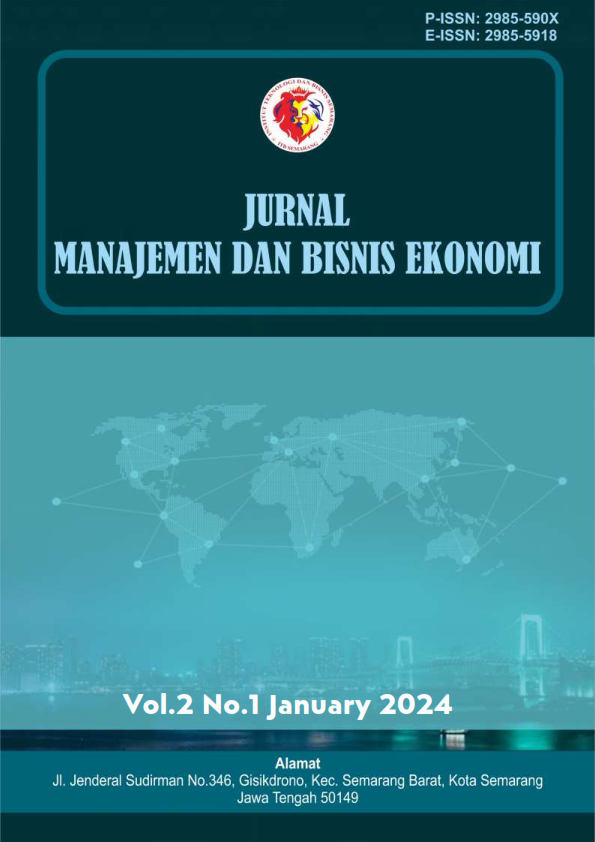Pengaruh Kinerja Keuangan Daerah Terhadap Alokasi Belanja Modal Provinsi Sumatera Utara
DOI:
https://doi.org/10.54066/jmbe-itb.v2i1.1087Keywords:
Regional Financial Performance, Capital Expenditure Allocation, Regional Revenue Budget (APBD)Abstract
This research aims to analyze the influence of regional financial performance on capital expenditure allocation. The data used is secondary data from 2018 to 2021 which comes from regional financial reports. Data analysis was carried out using multiple linear regression. The research results show that regional financial performance has a positive and significant effect on capital expenditure allocation. This shows that the better the regional financial performance, the greater the capital expenditure allocation that can be allocated. The ability of regional governments to manage their regional finances can be measured by analyzing regional financial performance. Regional financial performance consists of financial ratios. These financial ratios are used to assess regional financial independence in financing the implementation of regional autonomy, measure effectiveness and efficiency in realizing regional income, measure the extent of regional government activity in spending its regional income, measure the contribution of each source of income in the formation of regional income, see growth/development of income and expenditure during a certain period of time.
References
Antari, N. P. G. S., & Sedana, I. B. P. (2018). Pengaruh pendapatan asli daerah dan belanja modal terhadap kinerja keuangan pemerintah daerah (Doctoral dissertation, Udayana University).
Arif, M, and Fefri Indra Arza, ‘Analisis Keuangan Daerah Terhadap Alokasi Belanja Modal Pemerintah Daerah Di Kabupaten Dan Kota Provinsi Sumatera Barat Tahun 2013 – 2017’, Jurnal Eksplorasi Akuntansi, 1.1 (2019), 35–49
Azhari Akmal Tarigan, Buku Panduan Penulis Skripsi (Medan: Febi press, 2015) Fathah, Rigel Nurul, ‘Analisis Rasio Keuangan Untuk Penilaian Kinerja Pada
Hardani, dkk, Metode Penelitian Kualitatif Dan Kuantitafi (Yogyakarta: CV PustakaIlmu, 2020)
Havid sulasro, yanuar E. Restianto, ‘Pengaruh Kinerja Keuangan Terhadao Alokasu Belanja Modal, Dan Pertumbuhan Ekonomi Kabupaten,Kota Di Jawa Tengah’,Media Riset Akuntasi, Vol.1 No.2
Leki, Y., Naukoko, A. T., & Sumual, J. I. (2018). Pengaruh pendapatan asli daerah dan belanja modal terhadap kinerja keuangan pada pemerintah kabupaten halmahera barat. Jurnal Berkala Ilmiah Efisiensi, 18(5).
Muhammad Arif, ‘Universitas Sumatera Utara’, 2019
Pemerintah Daerah Kabupaten Gunung Kidul’, Ebbank, 8.1 (2017), 33–48 Padang, Nowventina Evenita, ‘Analisis Pengaruh Kinerja Keuangan Daerah
Terhadap Alokasi Belanja Modal Dengan Dana Alokasi Khusus Sebagai Variabel Moderating Pada Kabupaten / Kota Di Provinsi Sumatera Utara’, Tesis,2016, 1–90
Putri Retno Miranti, ‘ANALISIS PENGARUH KINERJA KEUANGAN DAERAH TERHADAP BELANJA MODAL KABUPATEN DAN KOTA DI PROVINSI JAWA BARAT TAHUN 2011-2015’, Ley N° 28294, 22, 2004, 1–5 (2017)
Putri, Rinta Seftyawati, and Sri Rahayu, ‘Pengaruh Kinerja Keuangan Pemerintah Daerah Terhadap Belanja Modal Di Provinsi Jawa Barat’, Jurnal Akuntansi, Audit Dan Sistem Informasi Akuntansi (JASa), 3.2 (2019), 256–68
Sugiyono, ‘Metode Penelitian Kuantitatif, Kualitatif, Dan RD’, 2017
Triyogi, Muhammad, Septi Anggoro, Program Studi Akuntansi, Sekolah Tinggi, Ilmu Ekonomi, Yayasan Keluarga, and others, ‘Pengaruh Kinerja Keuangan Daerah Terhadap Alokasi Belanja Modal Kabupaten Dan Kota Di Provinsi Sumatera Utara Ringkasan Skripsi’, 2021
Widodo, Edy, Eli Suriani, Intan Putri, and Gita Evi, ‘Analisis Regresi Panel Pada Kasus Kemiskinan Di Indonesia’, Prosiding Seminar Nasional Penelitian, 2 (2019),710–1
Downloads
Published
How to Cite
Issue
Section
License
Copyright (c) 2023 M. Irvan Fahrul Sitorus, Isnaini Harahap, Rahmat Daim Harahap

This work is licensed under a Creative Commons Attribution-NonCommercial-NoDerivatives 4.0 International License.







